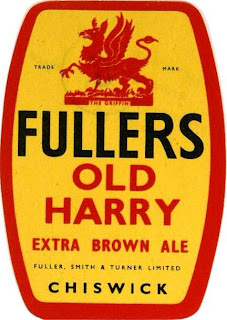Kristen was a little confused by the use of "H" instead of "X". Fullers use both in the logs to denote the same beer. Why? It's obvious to me, having drunk Fullers Mild in pubs. It was called Hock. The y still have something called the Hock Cellars in the brewery. Not that it often has any Hock in it nowadays. Fullers only occasionally brew Hock.
As I've already told you, I drank a later version of this beer several times. In fact my all-time quickest drinking was a Hock session. Back in 1979 when me and my mate Matt were working in an arms factory close to Old Street. We often drank in a Fullers pub called the George and Vulture at lunchtime.
But that wasn't where I performed my speed drinking stunt. It was in another pub. A beer place called the Bricklayers Arms. We nipped in there one dinner time when they had Hock on. In wonderful condition. (That was the problem with Hock. Lovely beer, but the few pubs that stocked it often couldn't sell it quickly enough.) It just slipped down. Real suicide beer - it couldn't help throwing itself down your throat. I managed 5 pints in little more than half an hour. Then back to operate heavy machinery.
The beer I drank in 1979 wasn't a million miles away from this one. About 3% ABV, dark in colour and brewed from a simple grist of pale malt, maize and sugar. It sounds awful when you list the ingredients like that, but I've learned not to fear adjuncts. The ber in the glass is all that counts.
X Ale is by far Fullers oldest beer. It's in all the brewing logs I've seen. They go back to 1887. I'm sure they were brewing it way back in the start in 1845. It's a shame it's so rarely brewed now.
Now it's time for Kristen to work his magic . . . . . . .
Kristen’s Version:
Notes: Only one ‘English’ malt is listed for this beer. In all actuality it had 5 different pale malts. Use as many as you’d like in this beer. If you want to use just a single one, I’d go with Maris Otter. Here is another instance where its going to pay off for you for making some much of the different inverts we’ve talked about over the years. In a pinch, or out of sloth, you can use Belgian Dark syrup. There is an awful lot of color that comes from the caramel so in this instance I would definitely suggest finding some.


Do the logs show how the colour of the X might have changed over time? (I'm assuming the gravity changes took place when one would expect ...)
ReplyDeleteMartyn, the logs say nothing directly about the colour. Unlike Whitbread and Barclay Perkins. The only data I have is from the Whitbread Gravity Book.
ReplyDeleteWorking it out from the ingredients is only guesswork. Some of the sugars and primings I don't know the exact make-up of.